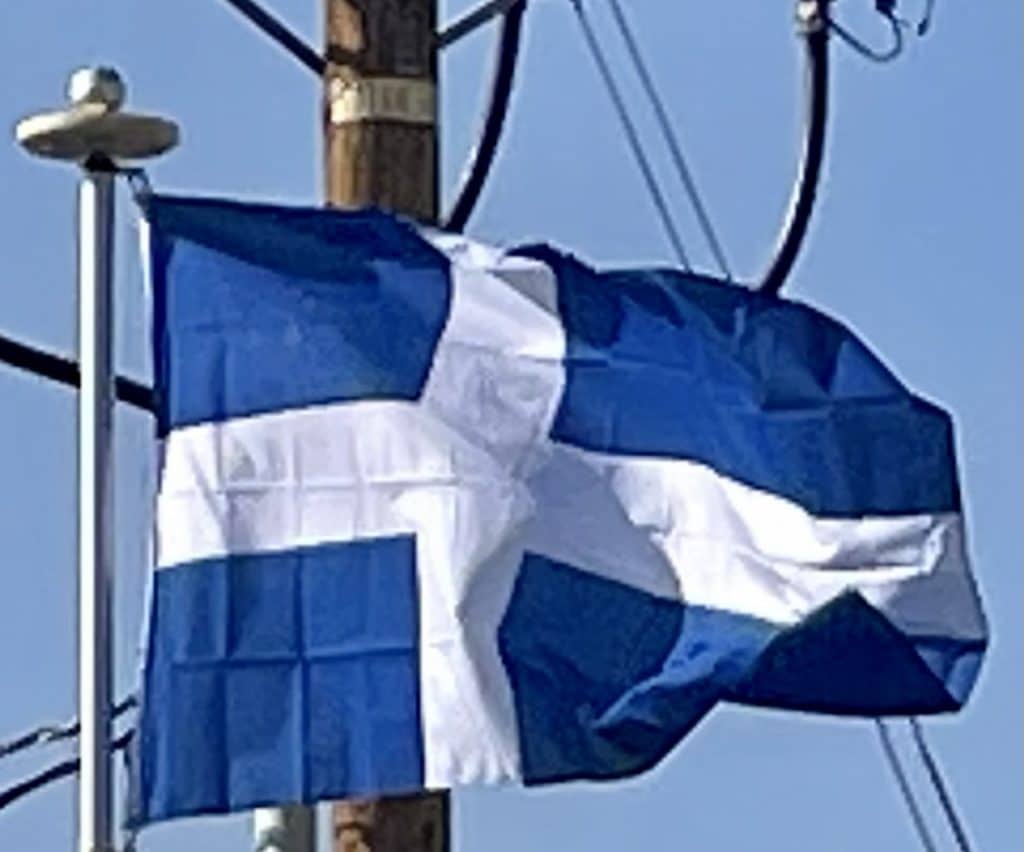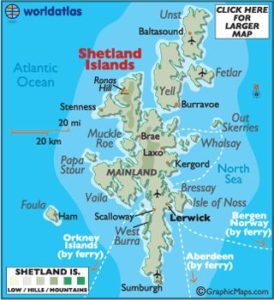

Shetland

20th century[edit]
During World War I, many Shetlanders served in the Gordon Highlanders, a further 3,000 served in the Merchant Navy, and more than 1,500 in a special local naval reserve. The 10th Cruiser Squadron was stationed at Swarbacks Minn (the stretch of water to the south of Muckle Roe), and during a single year from March 1917 more than 4,500 ships sailed from Lerwick as part of an escorted convoy system. In total, Shetland lost more than 500 men, a higher proportion than any other part of Britain, and there were further waves of emigration in the 1920s and 1930s.
During World War II, a Norwegian naval unit nicknamed the “Shetland Bus” was established by the Special Operations Executive in the autumn of 1940 with a base first at Lunna and later in Scalloway to conduct operations around the coast of Norway. About 30 fishing vessels used by Norwegian refugees were gathered and the Shetland Bus conducted covert operations, carrying intelligence agents, refugees, instructors for the resistance, and military supplies. It made over 200 trips across the sea, and Leif Larsen, the most highly decorated allied naval officer of the war, made 52 of them. Several RAF airfields and sites were also established at Sullom Voe and several lighthouses suffered enemy air attacks.
Oil reserves discovered in the later 20th century in the seas both east and west of Shetland have provided a much-needed alternative source of income for the islands. The East Shetland Basin is one of Europe’s prolific petroleum provinces. As a result of the oil revenue and the cultural links with Norway, a small Home Rule movement developed briefly to recast the constitutional position of Shetland. It saw as its models the Isle of Man, as well as Shetland’s closest neighbor, the Faroe Islands, an autonomous dependency of Denmark.
Geography:
Shetland is around 170 km (106 mi) north of mainland Scotland and 350 km (217 mi) west of Bergen, Norway. It covers an area of 1,468 km2 (567 sq mi) and has a coastline 2,702 km (1,679 mi) long.
Lerwick, the capital and largest settlement, has a population of 6,958 and about half of the archipelago’s total population of 22,920 people live within 16 km (9.9 mi) of the town.
Scalloway on the west coast, which was the capital until 1708, has a population of less than 1,000.

Only 16 of about 100 islands are inhabited. The main island of the group is known as Mainland. The next largest are Yell, Unst, and Fetlar, which lie to the north, and Bressay and Whalsay, which lie to the east. East and West Burra, Muckle Roe, Papa Stour, Trondra and Vaila are smaller islands to the west of Mainland. The other inhabited islands are Foula 28 km (17 mi) west of Walls, Fair Isle 38 km (24 mi) south-west of Sumburgh Head, and the Out Skerries to the east.
The uninhabited islands include Mousa, known for the Broch of Mousa, the finest preserved example in the world of an Iron Age broch; Noss to the east of Bressay, which has been a national nature reserve since 1955; St Ninian’s Isle, connected to Mainland by the largest active tombolo in the United Kingdom; and Out Stack, the northernmost point of the British Isles. Shetland’s location means that it provides a number of such records: Muness is the most northerly castle in the United Kingdom and Skaw the most northerly settlement.
Economy:
Today, the main revenue producers in Shetland are agriculture, aquaculture, fishing, renewable energy, the petroleum industry (crude oil and natural gas production), the creative industries and tourism. Unst also has a rocket launch pad called the Shetland Space Centre. A February 2021 news item indicated that a rocket manufacturer from Germany, HyImpulse Technologies, planned to launch spacecraft powered by hydrogen from the Space Centre, starting in 2023. During the previous month, the Space Centre had filed plans with Council for a “satellite launch facility and associated infrastructure”.
